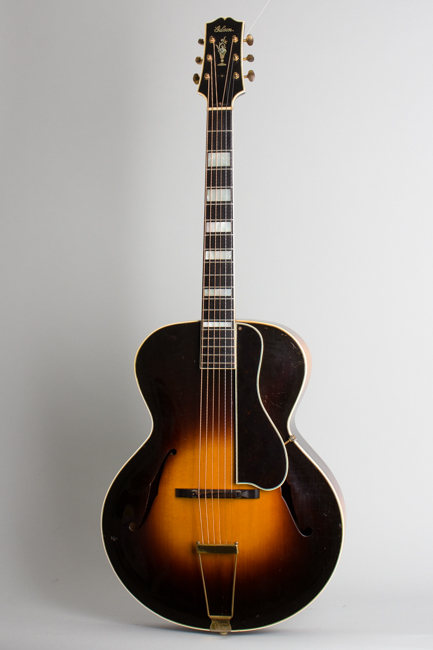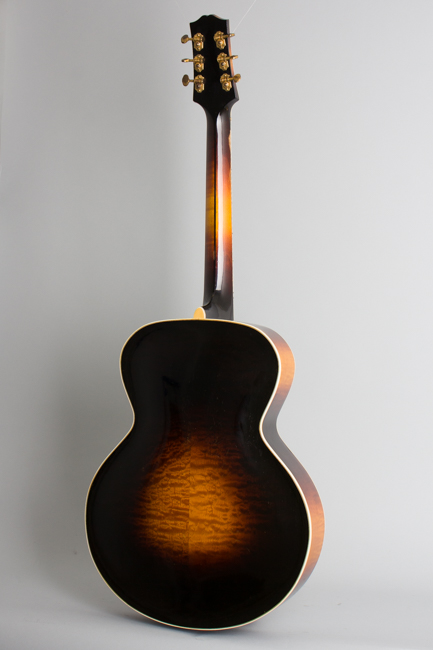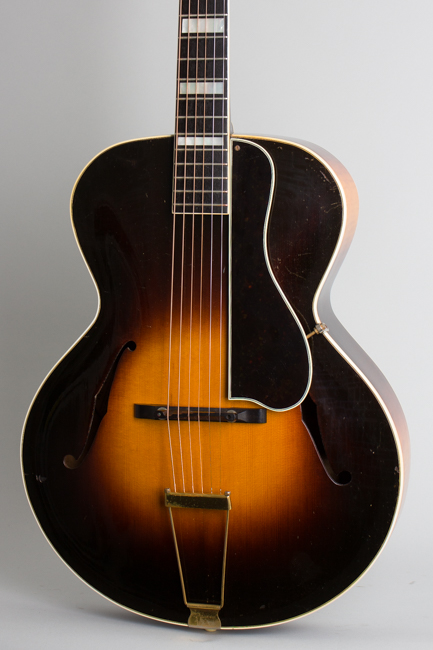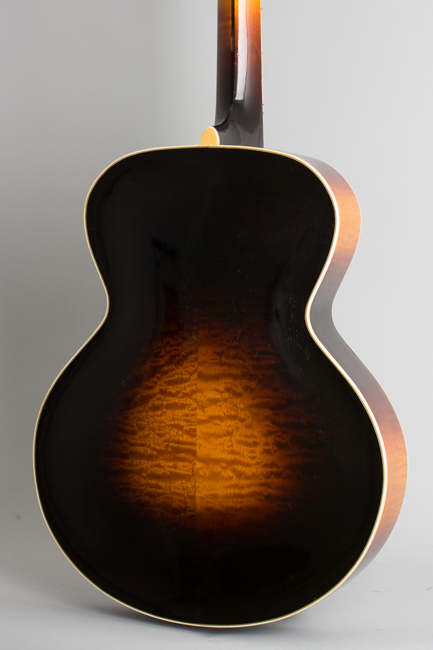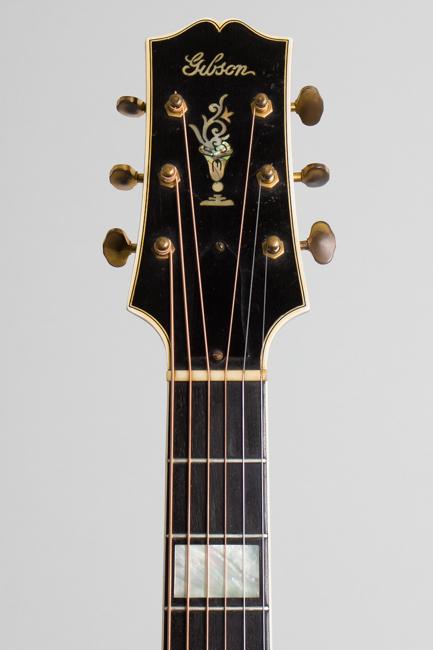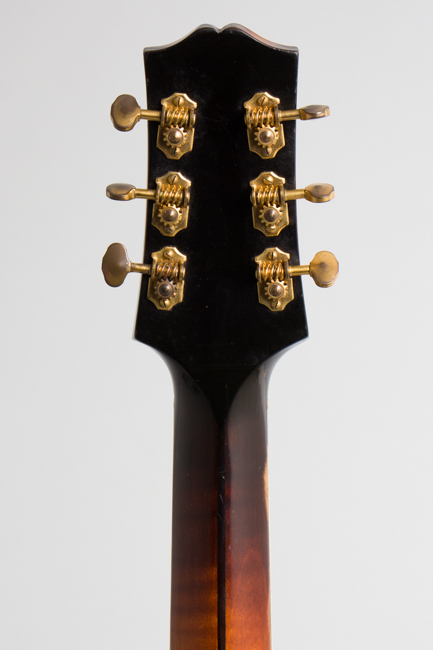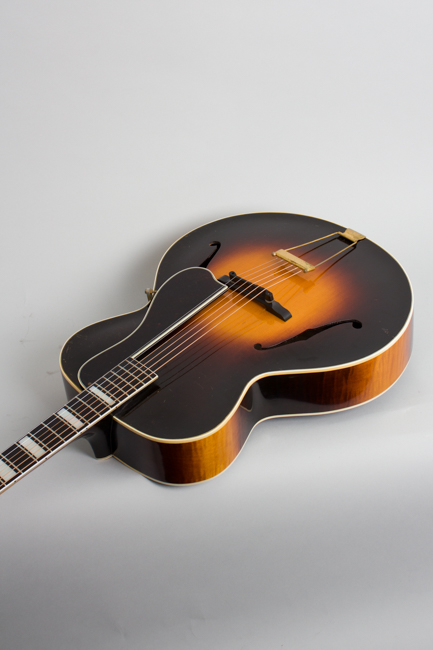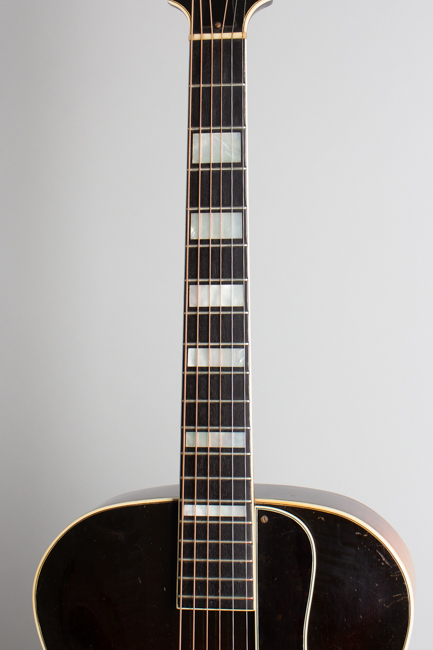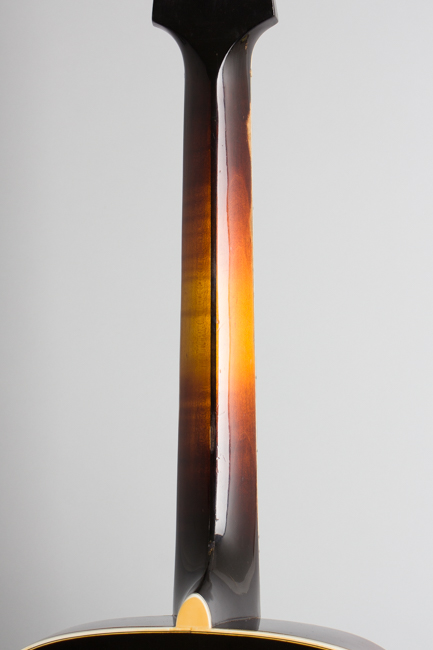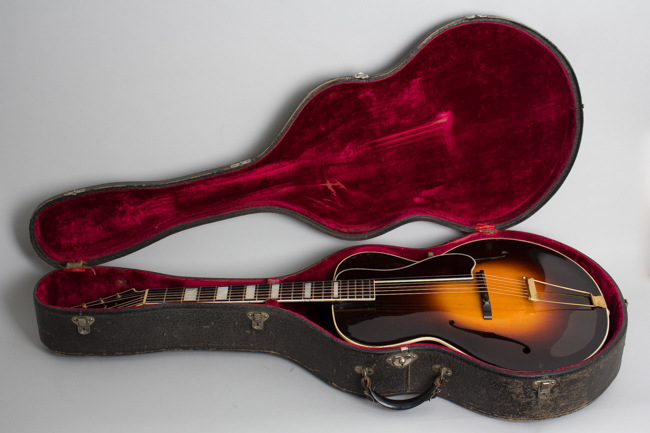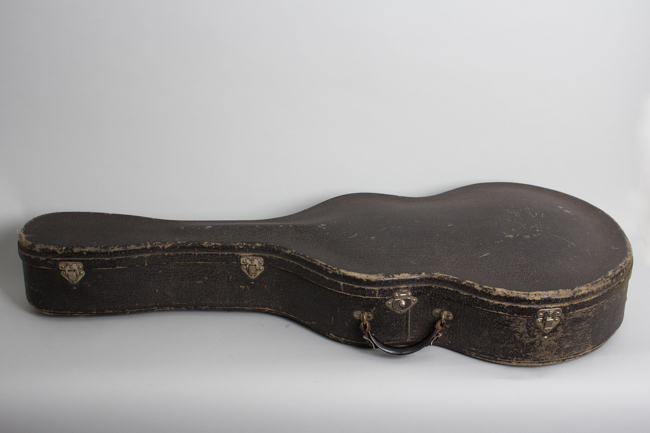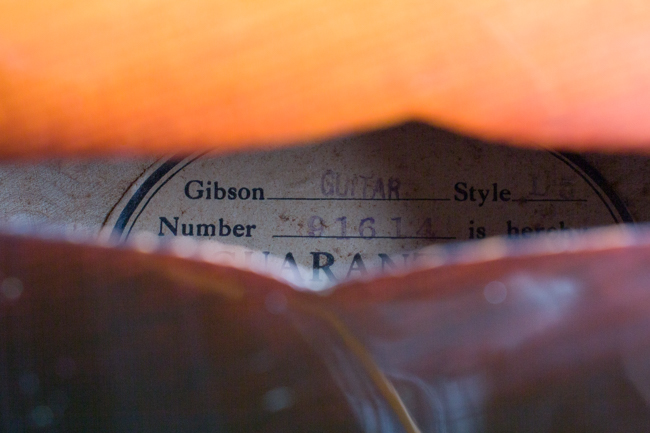Gibson L-5 Arch Top Acoustic Guitar (1935)
End of Summer Sale - PRICE REDUCED!
This item has been sold.
Item # 11365
Prices subject to change without notice.
Gibson L-5 Model Arch Top Acoustic Guitar (1935), made in Kalamazoo, Michigan, serial # 91614, Cremona Brown Sunburst finish, curly maple back and sides, spruce top; maple neck with ebony fingerboard, original black hard shell case.
This 1934-5 L-5 is a really superb example of the pre-eminent orchestra guitar of its era -- the original f-hole carved top guitar and an extremely fine-sounding instrument by any standard. L-5's were standard equipment for many top players of the day, and most of them show more signs of long service in the big-band era than this one.
Debuting in 1923-4, the L-5 was the first modern F-hole archtop. When this one was built ten years later it was still the top of Gibson's line, considered by most players the finest orchestra guitar made. In 1934 an L-5 or Epiphone's Deluxe were the only really functional choices for top professional guitar players. Eddie Lang, the era's most influential guitarist, used a 1920s dot-neck L-5, then an early block neck L-5 starting around 1931 setting the trend. From that time on the L-5 gave Gibson a dominance in orchestra guitars they never really lost.
That said, these early 16" L-5s are fairly rare guitars today. Retailing at $275.00 (plus case), this was an extremely expensive instrument for the time; the top-of-the-line Martin pearl-trimmed Style 0M-45 retailed at $100.00 less. At the height of the Depression, only working professionals with steady salaries could afford such an indulgence.
This example shows typical features for the early-mid 1930s 16" L-5; the transitions between variants are inexact at best. Based on the factory order and serial numbers this guitar was likely built in late 1934 and shipped in early '35. At that point the new 18" wide Super 400 and companion 17" wide "Advanced" L-5 were in the design stages but his original style L-5 still ruled the Gibson roost. In practice this was not an instant transition; some players preferred the older style L-5 and examples were still shipped from Kalamazoo for several years onward.
The top, back, and sides on this guitar carry a beautifully blended dark sunburst finish; the back is beautiful flamey maple with a pronounced figure. The top and back are triple bound in white celluloid. The braces are the "kerfed" style used since the early 1930's, a production expedient allowing faster build times. While this has become a much-discussed feature of late, we do not find tremendous sound differences between the L-5's of this era regardless of how they are braced.
The side-line bound, straight-end ebony fingerboard has real pearl block inlay, an upgrade from the pearloid used earlier. The 3-piece laminated curly maple neck has a medium-slim "V" profile, not quite as shallow as some examples. The pearl inlaid flowerpot in the triple-bound headstock with a straight across "Gibson" logo above are hallmarks of the 1932-35 L-5 as are the older style, gold plated Grover G-98 tuners with riveted gears and metal "butterbean" buttons. The long triple-bound celluloid pickguard is screwed to the top by the neck block. The gold plated tailpiece is the 1930's "string through" piece. The adjustable ebony bridge is the split base style used on most L-5's in this period; this one even still has the "turnover" saddle which could be flipped for Hawaiian playing still intact!
This instrument has a very even and versatile sound typical of these early L-5s; simultaneously warm and incisive with plenty of depth. It plays very comfortably and is extremely responsive for an archtop guitar, it even sounds lovely fingerstyle! The action is set fairly low as preferred by most modern players but can easily be raised for a more traditional punch. Most of these 1930s L-5s were played extensively for many years, some owners preferring them to any other guitar. They can be seen in the hands of recording studio players well into the 1960s. As constant working guitars, they were often modified, refitted, or refinished with little regard for originality. This example has no alterations and only minor wear, a truly delightful and inspiring example of one of our all-time favorite instruments.
Overall length is 40 3/4 in. (103.5 cm.), 16 in. (40.6 cm.) wide at lower bout, and 3 1/4 in. (8.3 cm.) in depth, measured at side of rim. Scale length is 24 3/4 in. (629 mm.). Width of nut is 1 3/4 in. (44 mm.).
This L-5 is about the best preserved of these 1930s models we have had, showing just minor wear and tear for nearly 90 years on the planet and remaining in excellent original condition. The original finish shows typical light checking, with some minor scratches, dings, dents overall and a few areas of loss to the lacquer. There are a few discreetly touched in spots here and there but no major finish work. The top has none of the heavy pickwear often encountered, just some dings and scratches with a deep case lid bite near the upper edge and some scratching off the bridge feet. The back and sides are very clean with minor scuffs, dings and chips. The back of the neck has some minor rubs through the lacquer.
There are no cracks at all, which is wonderful to find on a guitar of this age. There is a small spot on the back of the neck near the heel where the neck center laminate is dinged with a tiny piece missing, and a spot above that where a bit of it was dinged into and polished out a bit. Neither of these cause any structural or playing concerns. The ebony fingerboard, white-black-white binding, bone nut are all intact; what appear to be the original frets have been crowned down somewhat but are still in very playable condition with minimal subsequent wear.
The gold-plated Grover tuners are original; they and the tailpiece show some plating wear. Even the triple bound tortoise celluloid pickguard is original, showing no deterioration which is again delightful as so many are gone to dust by now. The neck angle is excellent and has never been reset, and the original adjustable bridge has never been altered.
This lovely L-5 is still housed in the original case, which has wear overall but is still in better than average condition. The guitar inside is a delightful example of the later 16" L-5, a joy to play and a classy guitar in every way. This one really feels like it has never been played up to its potential through almost 90 years, so perhaps the next owner can rectify that! Excellent - Condition.
This 1934-5 L-5 is a really superb example of the pre-eminent orchestra guitar of its era -- the original f-hole carved top guitar and an extremely fine-sounding instrument by any standard. L-5's were standard equipment for many top players of the day, and most of them show more signs of long service in the big-band era than this one.
Debuting in 1923-4, the L-5 was the first modern F-hole archtop. When this one was built ten years later it was still the top of Gibson's line, considered by most players the finest orchestra guitar made. In 1934 an L-5 or Epiphone's Deluxe were the only really functional choices for top professional guitar players. Eddie Lang, the era's most influential guitarist, used a 1920s dot-neck L-5, then an early block neck L-5 starting around 1931 setting the trend. From that time on the L-5 gave Gibson a dominance in orchestra guitars they never really lost.
That said, these early 16" L-5s are fairly rare guitars today. Retailing at $275.00 (plus case), this was an extremely expensive instrument for the time; the top-of-the-line Martin pearl-trimmed Style 0M-45 retailed at $100.00 less. At the height of the Depression, only working professionals with steady salaries could afford such an indulgence.
This example shows typical features for the early-mid 1930s 16" L-5; the transitions between variants are inexact at best. Based on the factory order and serial numbers this guitar was likely built in late 1934 and shipped in early '35. At that point the new 18" wide Super 400 and companion 17" wide "Advanced" L-5 were in the design stages but his original style L-5 still ruled the Gibson roost. In practice this was not an instant transition; some players preferred the older style L-5 and examples were still shipped from Kalamazoo for several years onward.
The top, back, and sides on this guitar carry a beautifully blended dark sunburst finish; the back is beautiful flamey maple with a pronounced figure. The top and back are triple bound in white celluloid. The braces are the "kerfed" style used since the early 1930's, a production expedient allowing faster build times. While this has become a much-discussed feature of late, we do not find tremendous sound differences between the L-5's of this era regardless of how they are braced.
The side-line bound, straight-end ebony fingerboard has real pearl block inlay, an upgrade from the pearloid used earlier. The 3-piece laminated curly maple neck has a medium-slim "V" profile, not quite as shallow as some examples. The pearl inlaid flowerpot in the triple-bound headstock with a straight across "Gibson" logo above are hallmarks of the 1932-35 L-5 as are the older style, gold plated Grover G-98 tuners with riveted gears and metal "butterbean" buttons. The long triple-bound celluloid pickguard is screwed to the top by the neck block. The gold plated tailpiece is the 1930's "string through" piece. The adjustable ebony bridge is the split base style used on most L-5's in this period; this one even still has the "turnover" saddle which could be flipped for Hawaiian playing still intact!
This instrument has a very even and versatile sound typical of these early L-5s; simultaneously warm and incisive with plenty of depth. It plays very comfortably and is extremely responsive for an archtop guitar, it even sounds lovely fingerstyle! The action is set fairly low as preferred by most modern players but can easily be raised for a more traditional punch. Most of these 1930s L-5s were played extensively for many years, some owners preferring them to any other guitar. They can be seen in the hands of recording studio players well into the 1960s. As constant working guitars, they were often modified, refitted, or refinished with little regard for originality. This example has no alterations and only minor wear, a truly delightful and inspiring example of one of our all-time favorite instruments.
Overall length is 40 3/4 in. (103.5 cm.), 16 in. (40.6 cm.) wide at lower bout, and 3 1/4 in. (8.3 cm.) in depth, measured at side of rim. Scale length is 24 3/4 in. (629 mm.). Width of nut is 1 3/4 in. (44 mm.).
This L-5 is about the best preserved of these 1930s models we have had, showing just minor wear and tear for nearly 90 years on the planet and remaining in excellent original condition. The original finish shows typical light checking, with some minor scratches, dings, dents overall and a few areas of loss to the lacquer. There are a few discreetly touched in spots here and there but no major finish work. The top has none of the heavy pickwear often encountered, just some dings and scratches with a deep case lid bite near the upper edge and some scratching off the bridge feet. The back and sides are very clean with minor scuffs, dings and chips. The back of the neck has some minor rubs through the lacquer.
There are no cracks at all, which is wonderful to find on a guitar of this age. There is a small spot on the back of the neck near the heel where the neck center laminate is dinged with a tiny piece missing, and a spot above that where a bit of it was dinged into and polished out a bit. Neither of these cause any structural or playing concerns. The ebony fingerboard, white-black-white binding, bone nut are all intact; what appear to be the original frets have been crowned down somewhat but are still in very playable condition with minimal subsequent wear.
The gold-plated Grover tuners are original; they and the tailpiece show some plating wear. Even the triple bound tortoise celluloid pickguard is original, showing no deterioration which is again delightful as so many are gone to dust by now. The neck angle is excellent and has never been reset, and the original adjustable bridge has never been altered.
This lovely L-5 is still housed in the original case, which has wear overall but is still in better than average condition. The guitar inside is a delightful example of the later 16" L-5, a joy to play and a classy guitar in every way. This one really feels like it has never been played up to its potential through almost 90 years, so perhaps the next owner can rectify that! Excellent - Condition.
